Sideboarding is what makes Magic tick as a game, compared to other TCGs or CCGs such as Hearthstone or Artifact. The opportunity to improve your deck after one game drastically reduces the variance inherent in card games. Players can easily lose due to mana issues or drawing cards in the wrong order, or simply having a bad matchup; but when you have access to a small sideboard, it gives you an opportunity to turn an unfavorable matchup into a favorable one.
With the growing popularity of Best of One matches on Arena, players are forgetting how powerful sideboards can be—unless you’re Ali Aintrazi. Even in Best of Three, many sideboards are copied or thrown together, meaning that players usually end up over-sideboarding or having a bunch of cards they never bring in because they don’t know what the cards are meant to do. Even sideboarding guides don’t give you a full picture to why a card is in the sideboard.
I’m here to give you some rarely considered sideboard cards. Give some of these a chance.
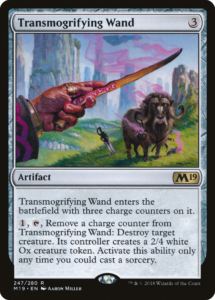
Transmogrifying Wand is most commonly found in the sideboard of Mono Blue tempo as a way to deal with the whole Izzet Drakes deck. It also provides a way of defeating Niv-Mizzet, Parun without triggering his ability, which is a bonus. The fact that the opponent gets a 2/4 Ox is close to irrelevant as the deck has so much evasion that you can out-race the tokens.
In my experience with Mono Blue on Arena and in paper, the card will catch players off guard. Opponents will tap out without realizing they could end up losing one of their few threats. Artifacts are difficult to destroy, so it usually sticks on board, dissuading opponents from playing future threats.
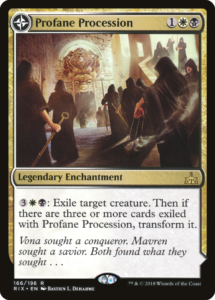
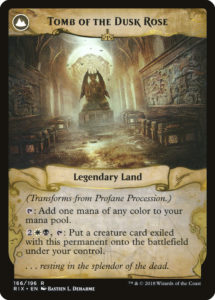
Profane Procession was one of the biggest limited bombs of all time. The Rivals of Ixalan standout looks like it could struggle in Standard because of Mortify and splash damage from players seeking to destroy enchantments like Conclave Tribunal and Ixalan’s Binding. The power level of the card is high enough that we should start to see more of it in Standard anyway.
Procession offers a repeatable removal spell that can transform into a win condition, using your opponent’s threats against them. If you are playing without your own creatures, opponents want have any removal after sideboarding, which means they can’t kill the creatures you steal from them. If that doesn’t appeal to the control player in you, then you’re playing control wrong!
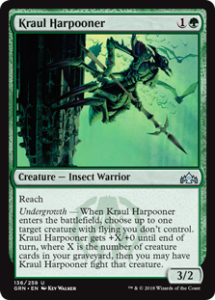
Kraul Harpooner was one of the more exciting cards coming out of Guilds of Ravnica. It fit the pre-existing mono-green aggro shell so easily. But we have seen it disappear from the radar, giving way to explore creatures like Merfolk Branchwalker and Wildgrowth Walker.
Mono-Blue Tempo is GBu’s worst match up, and Kraul Harpooner lines up incredibly well versus the deck. Even if you are unable to snipe an early Pteramander or Siren Stormtamer, you still have a lasting 3/2 reach body that is difficult to get through without Tempest Djinn. And later in the game the Harpooner trigger can trade with the djinn.
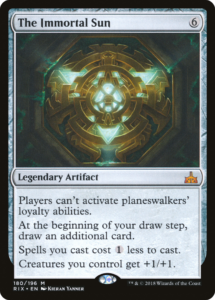
I always seem to write about The Immortal Sun, but the pure power level of the card is through the roof for any creature-based deck. While it’s potentially too expensive for a deck like Mono Blue to use, it really shines for a deck like Sultai, Gruul, or White aggro. It gives those decks a great source of card advantage while also being able to shut down troublesome planeswalkers like Vivien Reid or Ajani, Adversary of Tyrants.
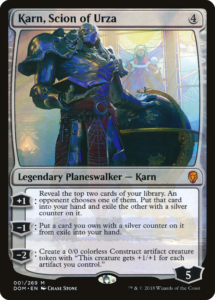
Maybe it is time for Karn, Scion of Urza to return to the fold after taking some time out of Standard spotlight. Karn generates threats over time, but more importantly it’s a source of card selection that’s difficult to interact with. With a starting loyalty of five, Karn is very difficult to remove immediately. You can expect to draw at least two cards with Karn before trying to win the game with Karnstructs. Being a colourless planeswalker also means that he can fit in any shell: from Izzet Drakes to Sultai Midrange even to Nexus decks.
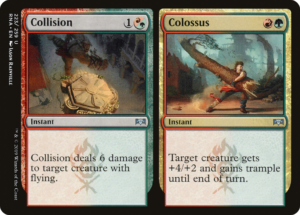
Collision // Colossus was the impetus for this article, thanks to a discussion with my local player group. Our local mono-red player was lamenting that Lava Coil was not very effective anymore and that he was losing to Niv-Mizzet, Parun, Lyra Dawnbringer, and Shalai, Voice of Plenty. Collision provides a clean answer to these permanents while also being a hybrid card, which means that green can use it instead of Plummet as well.
While the card is already in the main deck of some Gruul aggro decks, I have yet to see it appear in sideboards in comparison to Sagittars’ Volley. The second ability of Sagittars’ Volley doesn’t do much in Standard right now, so I would much rather play two-mana removal than pay three. This will change if spirits or a go-wide-style fliers deck ever becomes a thing, but for now I’d stick to playing Collision // Colossus. Besides, you can always dream of raging out with a giant tree trunk.
Those are cards we should expect to see more of in Best of Three Standard. While some of these do appear in lists already, the rest of the metagame needs to catch up or give them a chance. Arena starts offering ranked Best of Three, so now is the time to build your own sideboard! And remember, practice makes perfect.
Daniel Roberts (@Razoack) is a UK based player writing about all things Standard. Playing since the release of Gatecrash, he loves nothing better than travelling to European GPs with friends and losing in the feature match area. His best record is 12-3 at GP Barcelona 2017, but he’s aiming for that one more win.

